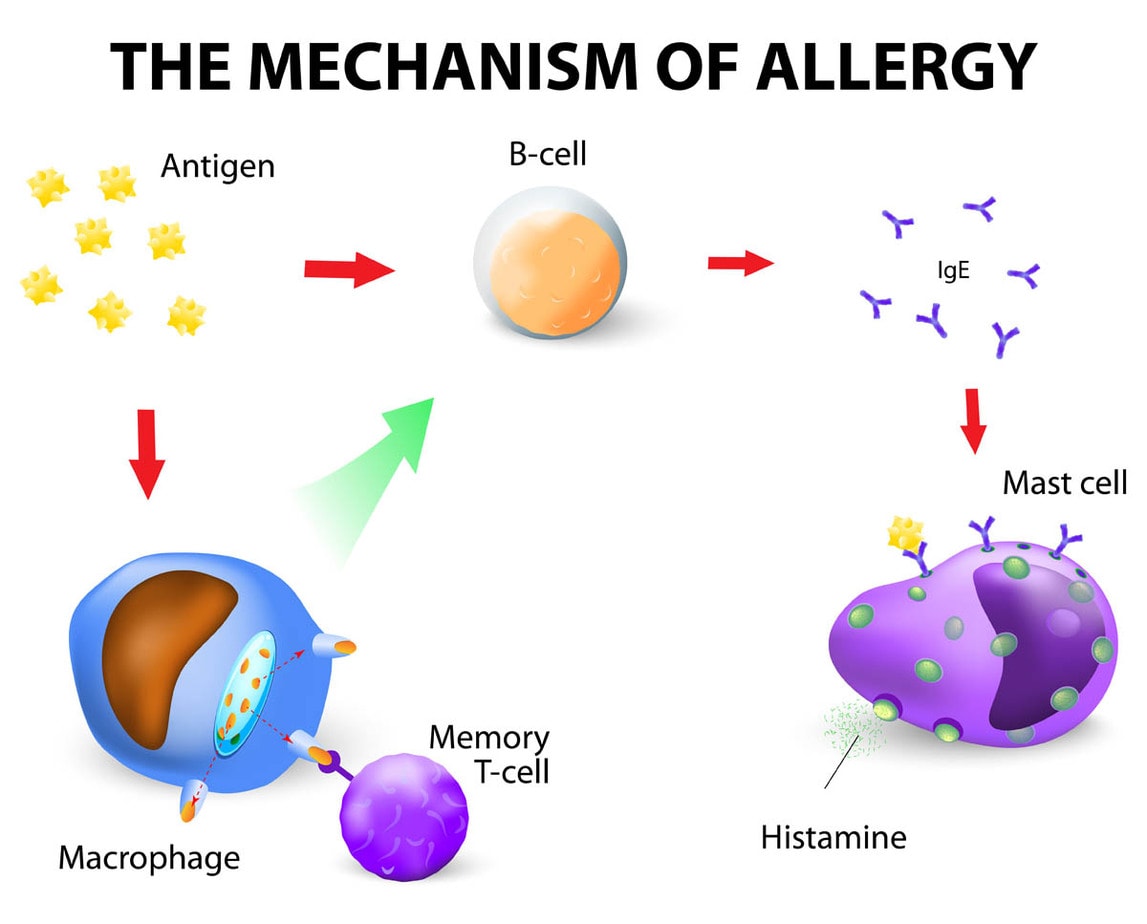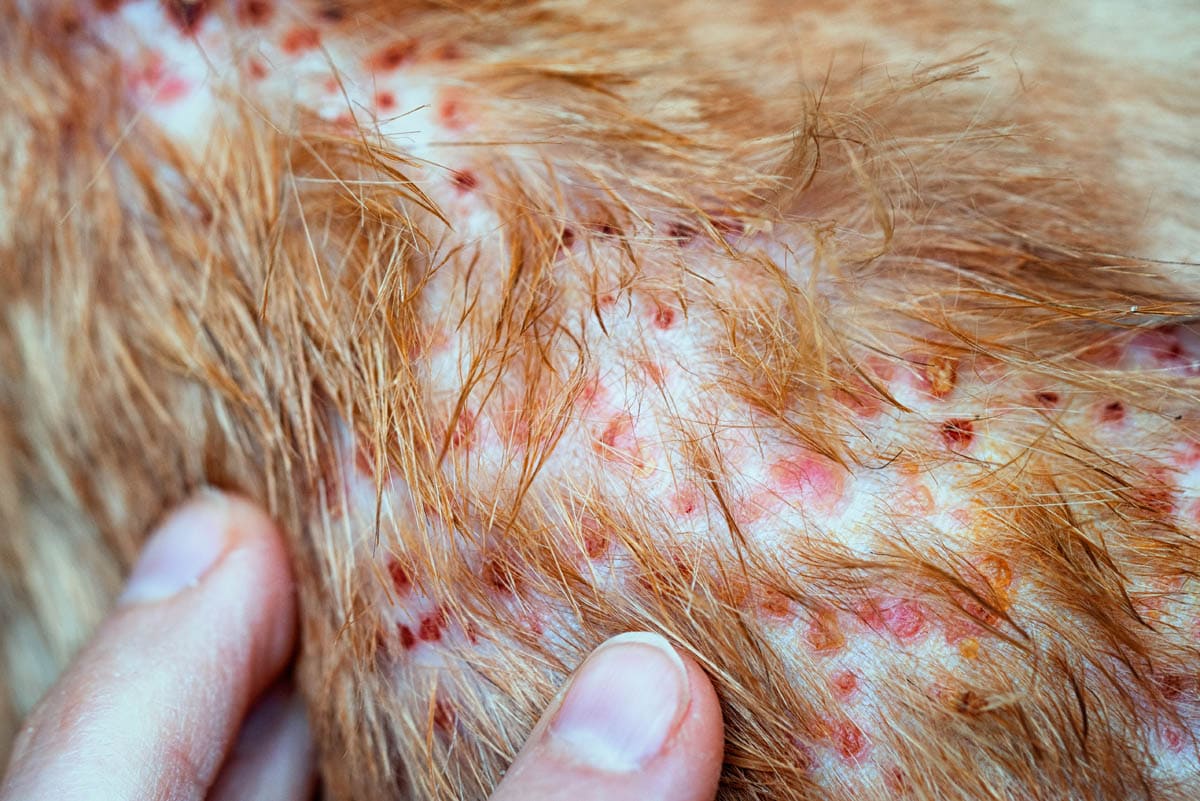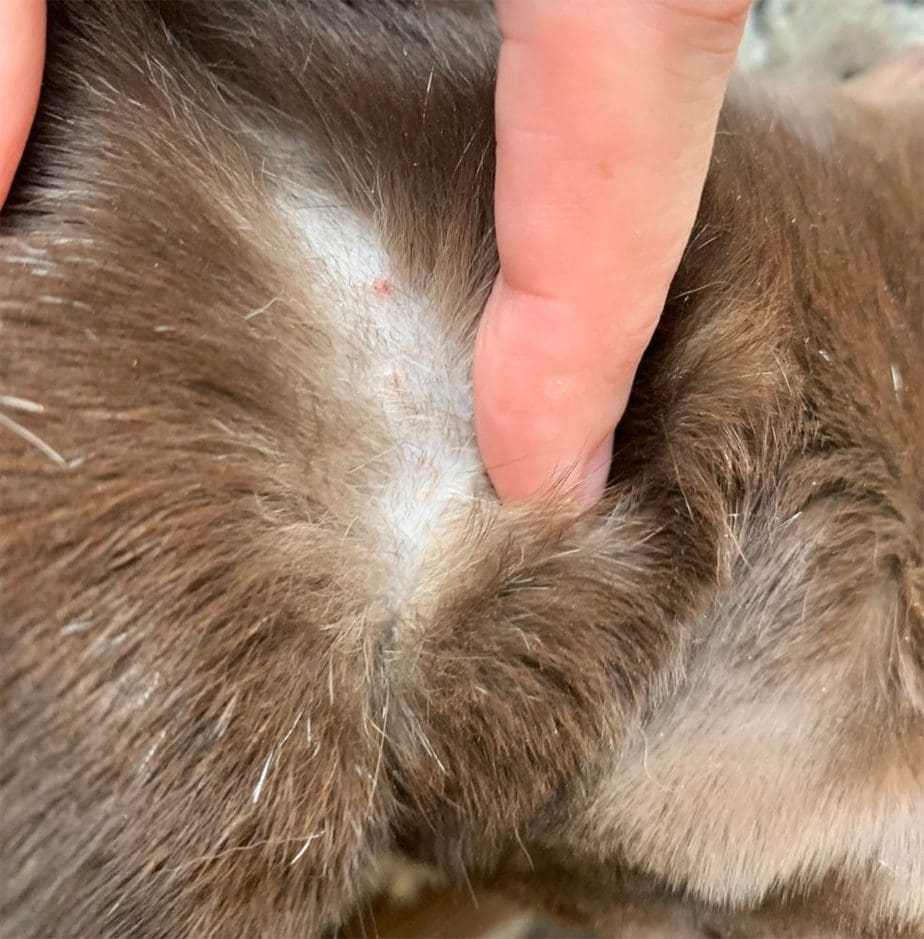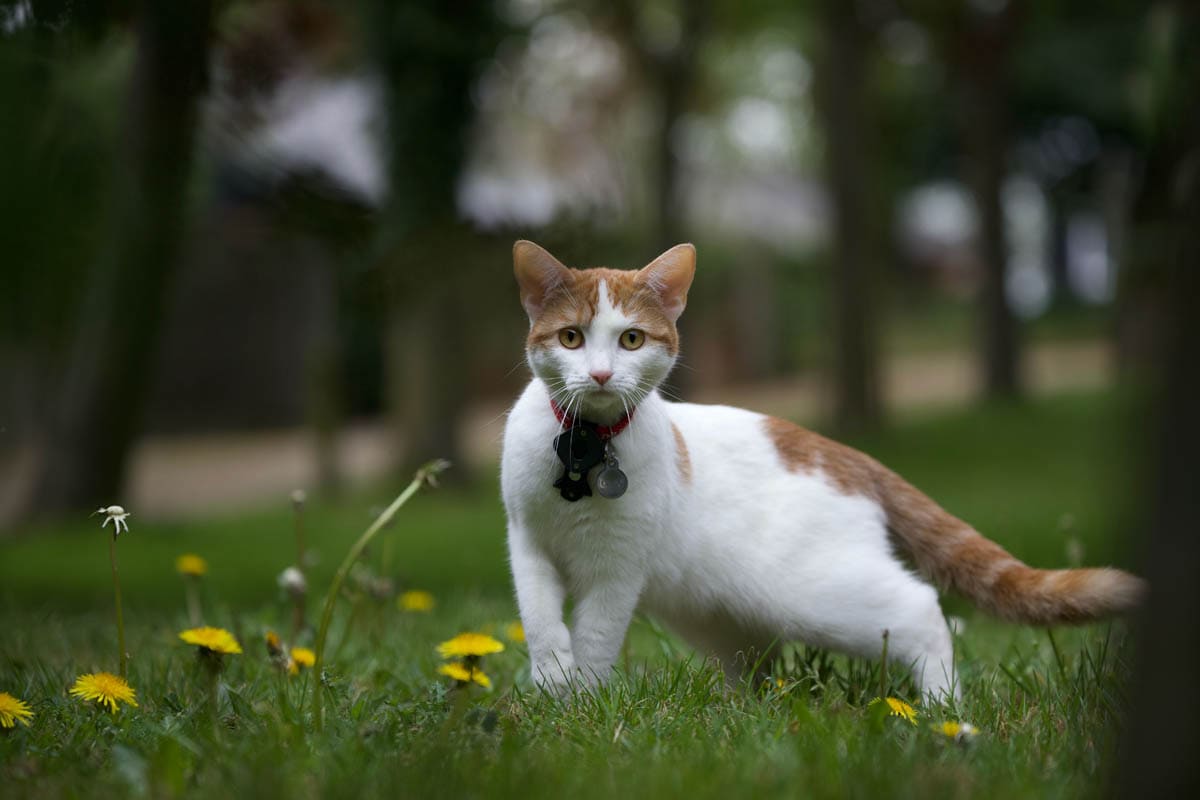What are allergies?
Allergies are an abnormal reaction by the cat’s immune system to a harmless substance that produces a cascade of symptoms such as itchiness and rash. The purpose of the immune system is to keep infectious microorganisms, such as certain bacteria, viruses, and fungi, out of the body, and to destroy any infectious microorganisms that do invade the body.

There are four causes of allergies in cats, insect, contact, inhalant, and food.
Insect allergies

Flea allergy dermatitis (FAD) is the most common dermatologic skin disease in cats. Flea saliva contains 15 known allergens; each one can trigger an allergic reaction in the cat with just one bite enough to cause an immediate or delayed allergic reaction.
Symptoms of insect allergies:
- Constant scratching and licking at the fur, especially over the base of the tail, back of the thighs and around the neck.
- Red, crusty bumps, especially around the head, neck, and back, often with intense itching.
Diagnosis of insect allergy:
- Characteristic lesions such as miliary dermatitis can provide your veterinarian with an index of suspicion your cat has insect allergies.
- Biopsy of the affected area to rule out other skin diseases.
- Treating the cat for fleas or keeping it inside which reduces exposure to mosquitoes to see if the condition improves.
Treatment:
- Eliminating fleas from the cat as well as the environment.
- Antibiotics to treat secondary bacterial infection.
- Antihistamines or steroids to control inflammation and reduce itching.
- Hyposensitisation (allergy shots/allergy desensitisation). This involves injecting gradually greater amounts of flea antigen in the hope that it will re-programme the immune system, so it’s not hypersensitive.
Food allergies
This is caused by an allergic reaction to one or more ingredients in the cat’s food with the most common causes of food allergies including are fish, beef, eggs, and wheat.
Symptoms of food allergies:
- Non-seasonal itching, especially on the front half of the body, head, face, ears, and neck.
- Swollen and or infected ears due to damage from scratching
- Hair loss due to excessive scratching and grooming
- Vomiting and/or diarrhea
Food allergies can present with the same skin signs as environmental or seasonal allergies. In this picture below, there is fur loss, swelling of the skin, red and inflamed skin, fur discoloration, broken skin, scans and crusting as a result of food allergies:

Diagnosis of food allergies:
Your veterinarian will place your cat on a food elimination trial which usually lasts between 8-12 weeks. During this time, you must not give your cat any other foods, vitamins, minerals or chewable medications apart from the prescribed diet.
If the allergy clears up after the specified time, then a food allergy is the likely cause. The diet given to your cat during the trial will be food your cat has never had before such as rabbit, duck or venison. It can be homemade or a prescription diet.
After the trial, you will need to challenge your cat by re-introducing one ingredient back into the diet. If after two weeks the re-introduced food hasn’t caused a flare-up then add another ingredient and so on. If the allergy returns with the re-introduction of the ingredient then this is eliminated from the diet once again.
Occasionally new food allergies develop over time. If this happens, then it will be necessary to re-evaluate the new diet.
Treatment:
Avoiding the food which caused the allergies is the best method of treatment which may either be a homemade diet or a prescription hypoallergenic diet such as Hills z/d which contain hydrolysed proteins which are proteins broken into pieces that are so small the immune system no longer reacts to them.
Learn more about food allergies in cats.
Inhalant (atophy) allergy
This is an allergic reaction from breathing pollens, dust mites, moulds and other allergens in the environment and is underdiagnosed in cats. [1] One study spanning 11 years found an atophy incidence of 12.5% in cats.
Symptoms of atophy:
- Intense itching which may be seasonal or continual
- Areas of redness and hair loss
- Facial crusty, scabby lesions
- Secondary skin infections due to constant trauma
Diagnosis of inhalant allergy:
Your veterinarian will obtain a complete medical history from you and perform a physical examination. He will want to rule out other possible conditions such as mange, flea allergy, contact dermatitis, ringworm, and food allergy.
- Skin scrapings and fungal cultures to rule out some of the conditions above.
- Intradermal skin test: A small amount of allergen is injected through the skin, which is then observed to determine if it elicits an allergic reaction. Certain medications such as antihistamines may interfere with results.
- Blood test: This tests for antibodies to specific antigens in the blood. Radioallergosorbent test (RAST) and enzyme-linked immunosorbent assay (ELISA). [2]
Treatment:
- Avoiding the cause of the allergy if possible is the ideal method to treat inhalant allergy but is often not possible because of an inability to identify the allergen or halt exposure.
- Hyposensitisation (allergy shots/allergy desensitisation). This involves injecting gradually greater amounts of the allergen in question in the hope that it will re-programme the immune system, so it’s not hypersensitive to the antigen.
- Corticosteroids are beneficial in relieving symptoms but are not a cure.
- Essential fatty acid supplements have also been effective in some cases of inhalant allergy.
Contact allergy
 This is the least common of the four types of allergy in cats and is a result of the cat coming into contact with a substance as the cat’s fur acts as a barrier, protecting it from allergy-producing compounds.
This is the least common of the four types of allergy in cats and is a result of the cat coming into contact with a substance as the cat’s fur acts as a barrier, protecting it from allergy-producing compounds.
There are two causes of contact dermatitis; allergic and irritant.
Irritant contact dermatitis:
Irritant dermatitis, the most common type of contact dermatitis, involves inflammation resulting from contact with acids, alkaline materials such as soaps and detergents, medications, solvents, or other chemicals.
Allergic contact dermatitis:
The second most common type of contact dermatitis is caused by exposure to a material to which the person has become hypersensitive or allergic. It arises some hours after contact with the responsible material, and settles down over some days providing the skin is no longer in contact with it. Plants, wool, medications are a common cause of allergic dermatitis in cats.
Symptoms of contact allergy:
- Non-seasonal itching, especially in areas where there isn’t much fur such as the chin, ears, toes, underbelly, and anus.
- Lesions of any type including redness, rash, papules (pimple-like), vesicles, and blisters
- Skin redness or inflammation
Diagnosis of contact allergy:
Your vet will perform a physical examination and take a history and will want to rule out other causes of dermatitis, such as flea bite hypersensitivity, first.
- Skin biopsy – This can help your veterinarian rule out other skin diseases and determine the allergen.
- A patch test – To determine if a specific substance is the cause of an allergic reaction. Several common allergens are applied to the skin; this is then covered with a bandage to protect the area. Examination of the skin at 24-48 hours may reveal redness and swelling at the site of a particular allergen.
- A presumptive diagnosis may be made by removing your cat from the environment for a week to see if the lesions begin to heal and then come back once returned to the environment.
Treatment:
- Identification and elimination of the substance causing contact allergy.
- Corticosteroids to relieve itching.
- Antibiotics if a secondary bacterial infection has developed.
References:
[1] Cat Health Encyclopedia – Lowell Ackerman (p 14)
[2] The Feline Patient -Gary D. Norsworthy, Mitchell A. Crystal, Sharon K. Fooshee, Larry P. Tilley (p 122)

